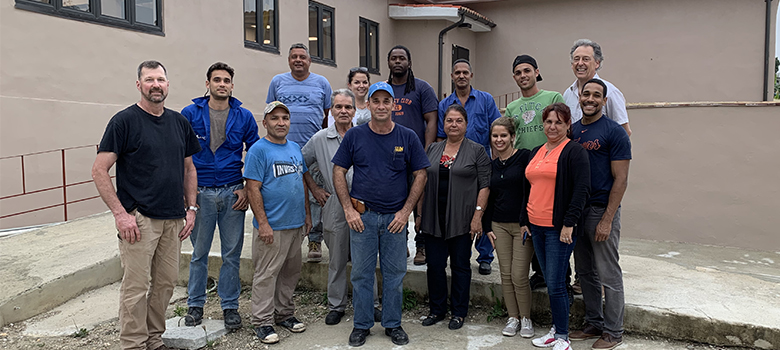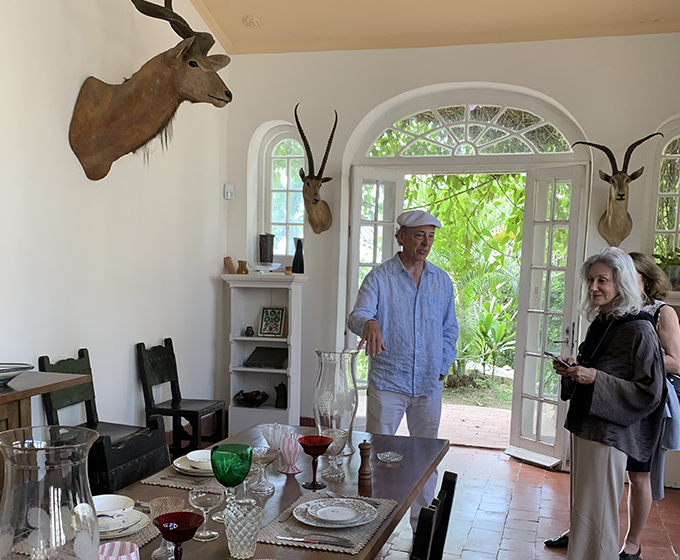
Dupont and the U.S. Technical Team that designed the new restoration center. Photo credit: Rachel Sau Garcia, executive secretary of the Ernest Hemingway Museum
(July 8, 2019) -- UTSA historic preservation and architecture professor William Dupont, working with the Boston based Finca Vigia Foundation and many conservation experts from the U.S. and Cuba, has been collaborating on a multi-year project to restore and enhance Finca Vigia, Ernest Hemingway’s estate in Havana, Cuba. Under Dupont’s leadership of the U.S. Technical Team, the collaborations have led to recent completion of a climate-controlled restoration center at Finca Vigia, now a museum dedicated to preservation of Hemingway’s legacy in Cuba.
Hemingway lived at Finca Vigía from 1939 to 1961, the last 22 years of his life. The property was Hemingway’s primary home and thus it is a time capsule of his life, including all his belongings and thousands of priceless documents. The Museo Ernest Hemingway is one of the most popular tourist destinations in Cuba today.
“The architectural style of the house, patios and grounds is direct and unadorned,” said Dupont, “not unlike Hemingway’s writing style. Visitors can experience his place of creative inspiration in Cuba and observe the connections between residence and writer, gaining a deeper understanding of his artistic works.”

Dupont inside Finca Vigia. Photo credit: Kathryn Kanzle
Dupont serves as the San Antonio Conservation Society Endowed Professor of Architecture at UTSA. Drawing on a historic preservation career spanning more than three decades, he led the U.S. team in jointly designing the new restoration center with Cuban professionals, also specifying construction materials supplied by the U.S. team and working on construction management issues.
The U.S. team was formed 15 years ago and includes experts in architecture, historic preservation, structural and mechanical engineering, document conservation, and landscape architecture, plus specialists in metals, wooden boats, collections care, disaster planning and construction management. As part of the overall effort, U.S. and Cuban conservators have worked collaboratively since 2002 in support for the preservation of thousands of flat documents, photographs, and books in the museum’s collection.
US team members were carefully selected for their special skills and willingness to work under difficult conditions. “On top of experience, we wanted people who would be respectful, patient, and committed to the project,” Dupont explained, “because the Cuban professionals are highly qualified themselves, and they seek collaboration with us, not direction from us. “
The Restoration Center, built in three phases, provides archival storage with temperature and humidity controls for the preservation and longevity of the documents. It made history as the first construction projects based in Cuba built with U.S. supplies since the embargo of the early 1960’s. The overall collaboration, which included restoration of the main house completed in 2008, has been ongoing with approval of both nation’s governments since 2005. Efforts at the main house were based upon the review of hundreds of archival photographs from the Hemingway collection at the John F. Kennedy Presidential Library in Boston Massachusetts, as well as the Museo Hemingway’s collection, to inform the preservation treatments.
Presently, more than 50% of the Hemingway collection has been conserved and can be preserved in perpetuity at the Restoration Center. The Hemingway collection includes invaluable written documents, photographs of the author’s trips and letters he received from and/or sent to Marlene Dietrich, Ingrid Bergman, F. Scott Fitzgerald, Joan Miro and Maxwell Perkins. The collection also includes five scrapbooks created by the author. One is a collection of Nobel Prize congratulatory telegrams from around the world. One can also find notes with Hemingway’s favorite recipes and their preparation instructions for his kitchen staff.
“Since the project began, thousands of documents have been digitized. The original remains in Cuba, but digital images are removed and brought to the Kennedy Library for Hemingway scholars, school children, and Hemingway lovers to see. We’re not done. At lot of work remains in the advanced conservation of Hemingway’s books and oversized objects such as his vast map collection” said Mary-Jo Adams, Executive Director of the Finca Vigia Foundation.
“Quite interesting to those who study Hemingway, the authors written musings are found in approximately 18% of the vast 9,000 book collection. Preservation of these irreplaceable papers could not have occurred without the tremendous leadership of Professor Dupont and his team. Our Foundation is incredibly grateful” said Adams.
Prior to the preservation efforts, some of the documents found at Finca Vigia were more than 90 years old and fragile, slowly deteriorating due to the passage of time and the humid climate of Havana.
The overarching initiative was funded by The Ford Foundation, Caterpillar Inc., Caterpillar Foundation, AT&T Foundation, American Express Philanthropy, Intel, Emulex, and EMC Corporation.
Learn more about William Dupont.
Learn more about the College of Architecture, Construction and Planning and meet its Historic Preservation faculty.
Learn more about the San Antonio Conservation Society.
Celebrate UTSA’s 50th Anniversary and share social media posts about the 50th using the hashtag #UTSA50.
Connect with UTSA online at Facebook, Twitter, YouTube, Instagram and LinkedIn.
UTSA Today is produced by University Communications and Marketing, the official news source of The University of Texas at San Antonio. Send your feedback to news@utsa.edu. Keep up-to-date on UTSA news by visiting UTSA Today. Connect with UTSA online at Facebook, Twitter, Youtube and Instagram.
Move In To COLFA is strongly recommended for new students in COLFA. It gives you the chance to learn about the Student Success Center, campus resources and meet new friends!
Academic Classroom: Lecture Hall (MH 2.01.10,) McKinney Humanities BldgWe invite you to join us for Birds Up! Downtown, an exciting welcome back event designed to connect students with the different departments at the Downtown Campus. Students will have the opportunity to learn about some of the departments on campus, gain access to different resources, and collect some giveaways!
Bill Miller PlazaCome and celebrate this year's homecoming at the Downtown Campus with food, games, giveaways, music, and more. We look forward to seeing your Roadrunner Spirit!
Bill Miller PlazaThe University of Texas at San Antonio is dedicated to the advancement of knowledge through research and discovery, teaching and learning, community engagement and public service. As an institution of access and excellence, UTSA embraces multicultural traditions and serves as a center for intellectual and creative resources as well as a catalyst for socioeconomic development and the commercialization of intellectual property - for Texas, the nation and the world.
To be a premier public research university, providing access to educational excellence and preparing citizen leaders for the global environment.
We encourage an environment of dialogue and discovery, where integrity, excellence, respect, collaboration and innovation are fostered.